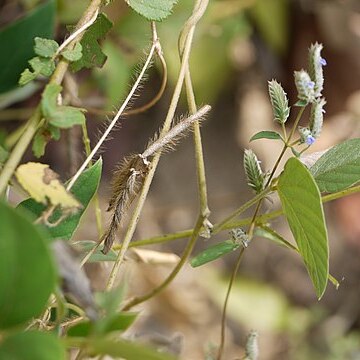Twining vines climbing on herbs and shrubs, the stems hispid, glabrescent. Leaves pinnate trifoliolate; leaflets ovate, apically acute or obtuse, mucronate, basally rounded, mostly 2-6 cm long, 1.5-2.5 cm wide, mostly copiously pubes-cent on both sides, more so beneath, the hairs sometimes appressed; petiolules 1-2 mm long, hispid; stipels subulate, the stipules subulate, sparingly long hispid. Inflorescences axillary racemes, mostly short, 2-5(-12) cm long, peduncle slen-der, retrorsely pilose, glabrescent in fruit; bracteoles ca. 2 mm long, about as long as the calyx tube. Flowers inconspicuous, white or pinkish; calyx tubular, ascending hispid, the tube ca. 2 mm long, the teeth subequal, about equalling the tube, the standard exserted about 1 mm from the calyx teeth. Legume linear, somewhat compressed, 3-5 cm long, mostly 5-6 mm wide, sericeous; seeds tan with dark mottling, plump lenticular, 4 mm long.
Stems slender, to 4 m, angular, densely appressed yellow tomentose. Stipules lanceolate; petiole 1.5-4 cm; stipels linear, ca. 3 mm; leaflets membranous, terminal leaflet oblong or long ovate, 2.5-6 × 1-2.2 cm, abaxially densely hairy, adaxially glossy and appressed scattered yellow pubescent, lateral veins 5 or 6 pairs, base rounded, apex acute. Racemes axillary, 2.5-4 cm, with 6-10 flowers, appressed hairy; peduncle ca. 2 cm; bracts lanceolate; pedicels ca. 5 mm; bracteoles at base of calyx, similar to bracts. Calyx 3-4 mm, appressed pubescent, 5-lobed; teeth ovate-lanceolate and shorter than calyx tube. Corolla white, changing to pink or purple; standard ca. 4 mm; wings oblong, truncate at base; keel rhombic. Ovary hairy. Legumes linear, ca. 4 cm × 3.5-4 mm, nodding, pubescent, hooked at apex. Seeds 5-9, oblong-ellipsoid, ca. 4 × 2 mm. Fl. Jun-Jul, fr. Sep-Oct.
Perennial herb, climbing, trailing or prostrate, much branched from a woody rootstock, roughly appressed-hairy throughout. Leaves pinnately trifoliolate. Leaflets ovate to narrowly elliptic, mostly rounded at base, stipulate. Inflorescences slender, few-flowered, axillary racemes, or flowers paired or fascicled in leaf axils; bracts small. Flowers small, white or yellow, sometimes with a pinkish flush. Flowering time Nov.-Apr. Pod linear, 2-valved, septate, tipped with persistent and hooked style.
A variable climbing or trailing herb. It grows 30 cm to 3 m long. The rootstocks are woody and the stems slender. Sometimes plants root at the nodes. The leaves are made up of rounded leaflets 1-8 cm long by 0.5-4 cm wide. They taper towards the tip and are rounded at the base. The leaf stalk is 0.9-4 cm long. The flowering stalk is slender with few flowers. The fruit are 2.5-6 cm long and 2-4 mm wide. The seeds can be smooth or covered with a grainy crust. There are 2 subspecies in West Africa.
Leaflets 1–7 × 0.5–3.5 cm, lanceolate, elliptic, ovate or obovate, glabrous to densely hairy on both surfaces; petiole 0.9–4.5 cm long; rhachis 1–5 mm long; petiolules 1–3 mm long.
Calyx tube 1–3 mm long, glabrescent or hairy; lobes 1–3 mm long, usually densely hairy, upper ones fused along two-thirds of their length.
Inflorescences few-flowered; rhachis 0.3–8 cm long; peduncle 0.5–2.5 cm long; pedicels 1–3 mm long; bracteoles 1–2 mm long, linear.
Pods 2.5–5.5 cm × 2–4 mm, linear, glabrescent to covered with dense appressed or rarely spreading hairs; beak 2–3 mm long.
Seeds sand-coloured to dark brown, 2–3 × 1–2 × 1 mm, oblong, smooth or granular, with a small rim aril.
Standard 4–5 × 3–4 mm, obovate, white, pink or lilac or purplish; wings lilac; keel white.
A very variable perennial climber or prostrate herb.
A slender-stemmed twiner
Small reddish flowers.

